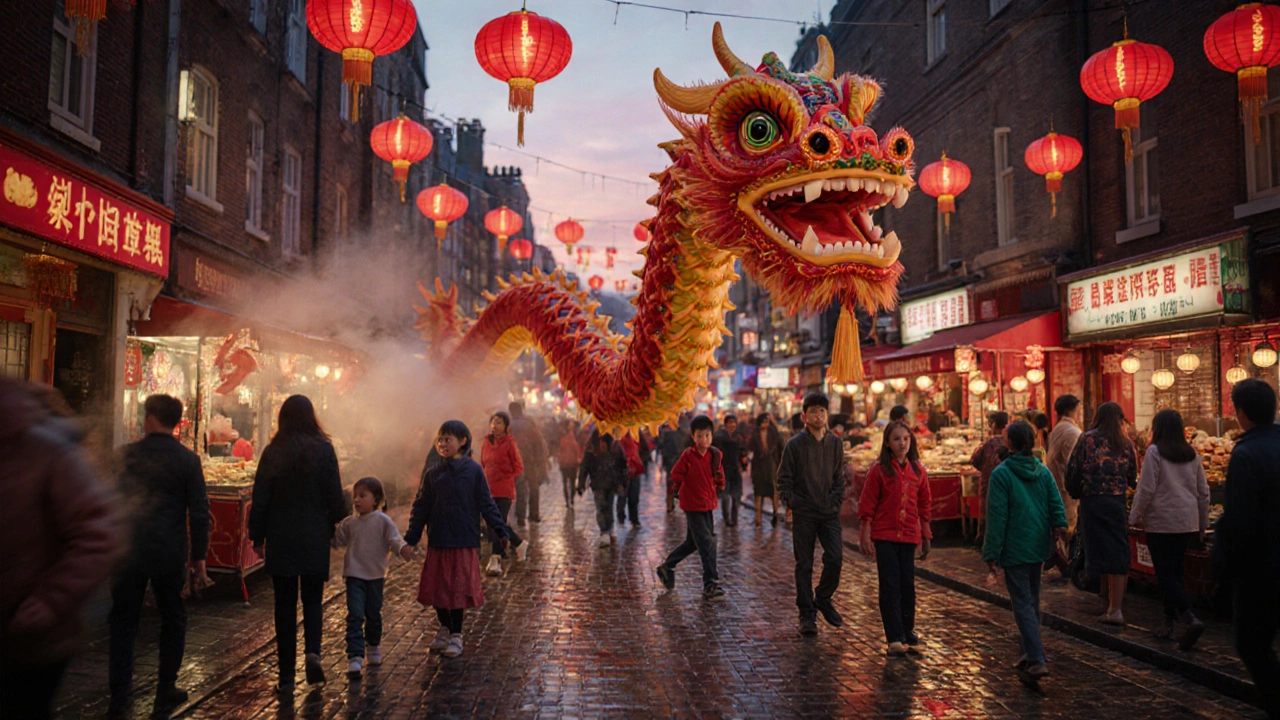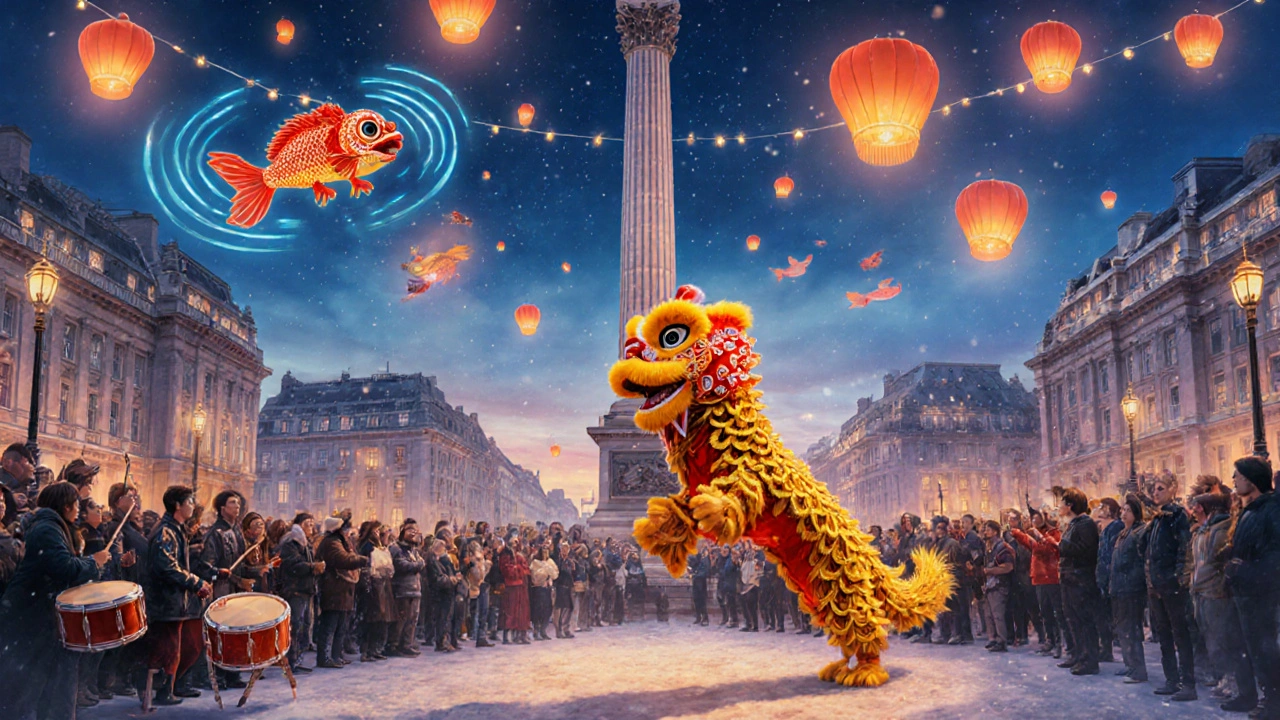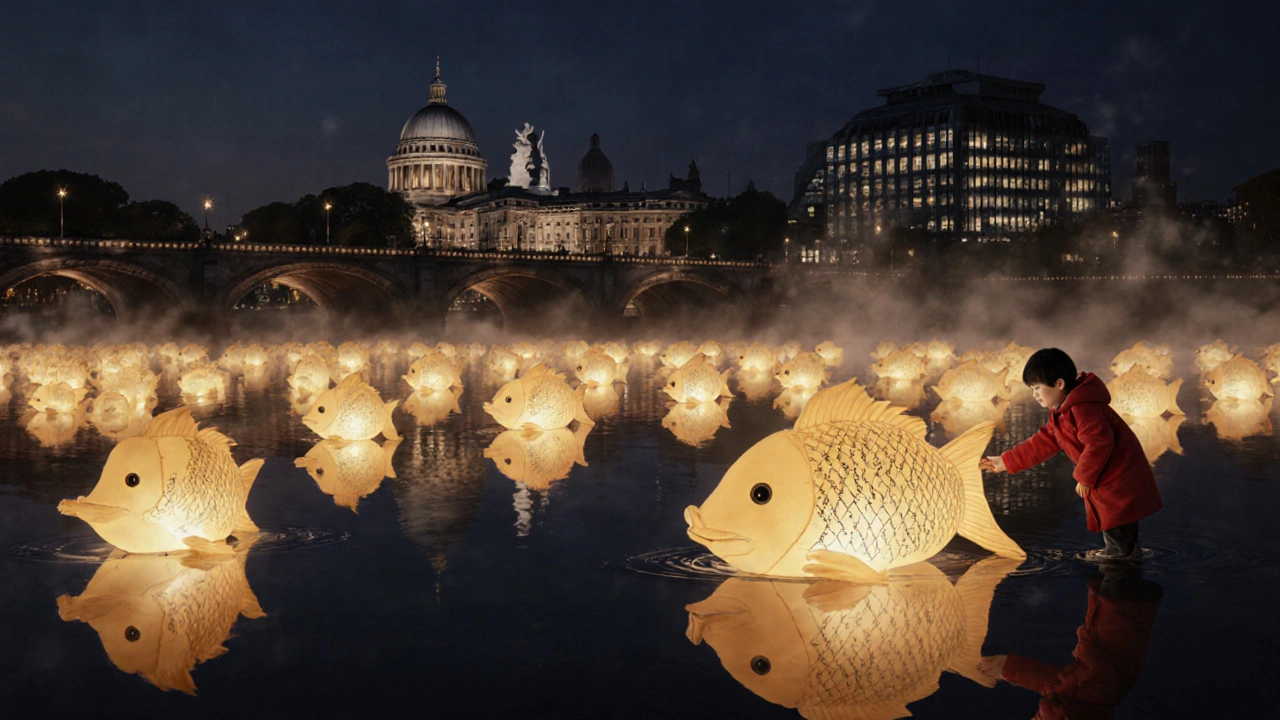
Every year in late January or early February, London transforms. The streets of Chinatown light up with red lanterns, drums echo through Leicester Square, and the scent of dumplings and incense fills the air. This isn’t just a parade - it’s the Lunar New Year, the biggest Asian cultural celebration in the UK, and it’s happening right in the heart of London.
What Makes the Lunar Festival in London Unique?
The Lunar New Year isn’t one single event. It’s a week-long series of performances, food stalls, dragon dances, and family gatherings that draw over 500,000 people each year. Unlike other festivals that feel like tourist shows, London’s celebration is deeply rooted in community. It’s organized by local Chinese, Vietnamese, Korean, and Malaysian groups who’ve lived here for decades. They don’t just recreate traditions - they adapt them.
Take the dragon dance, for example. In Beijing, it’s performed by trained troupes in ceremonial robes. In London, it’s led by teenagers from Southwark schools who learned the moves from their grandparents. The dragon is 60 feet long, made of silk and bamboo, and carried by 12 people who move as one. It doesn’t just wind through the streets - it visits local businesses, stopping at shops and restaurants to bless them with luck for the year ahead.
Where to Experience the Real Deal
If you’re looking for the heart of the festival, start in Chinatown. But don’t stop there. The real magic spills into Soho, Trafalgar Square, and even the Southbank Centre. Here’s where to go:
- Chinatown: The traditional hub. Look for the giant red arches on Gerrard Street. Street vendors sell steamed buns, mooncakes, and candied haws. The line for hot soup dumplings at Dim Sum House starts forming at 9 a.m.
- Trafalgar Square: This is where the main stage is. Free performances run all day - lion dances, martial arts demos, traditional opera. In 2024, over 30,000 people showed up just for the 2 p.m. dragon parade.
- Southbank Centre: More cultural depth here. You’ll find calligraphy workshops, paper-cutting classes, and talks by historians on the origins of the festival. It’s quieter, but the most authentic.
- Leicester Square: The party zone. Live music, DJs mixing traditional guzheng with electronic beats, and pop-up bars serving plum wine cocktails.
Most events are free. But if you want to sit in the front row at Trafalgar Square, arrive by 10 a.m. The best spots go fast.
The Food You Can’t Miss
Food is the soul of the Lunar Festival. Each dish carries meaning. Noodles symbolize long life. Fish means abundance. Sticky rice cakes stand for growth and prosperity.
Don’t just eat - know what you’re eating:
- Whole steamed fish: Served with the head and tail intact. It’s not just a meal - it’s a ritual. You leave the head and tail untouched to bring luck into the new year.
- Yusheng: A raw fish salad tossed with shredded vegetables and plum sauce. In Singapore and Malaysia, families toss it high while shouting “Lo Hei!” - meaning “toss up good fortune.” You’ll find it at Golden Dragon in Chinatown.
- Turnip cake: Fried cubes of grated radish and rice flour. Crispy outside, soft inside. Sold by the slice from carts near Soho Square.
- Red envelope candies: Small chocolates wrapped in red foil. Kids collect them like Halloween treats. The red stands for protection from evil spirits.
Pro tip: Bring cash. Many small vendors don’t take cards. And if you see a family offering food to strangers - say yes. It’s a gesture of generosity, not a sales pitch.

Why This Festival Matters in London
London’s Lunar New Year isn’t just about culture. It’s about belonging. After decades of immigration, the Asian community here has grown from a few thousand in the 1970s to over 1.8 million today. The festival is their voice. It’s how they say: we’re here. We’re not tourists. We’re part of this city.
It’s also changing how Londoners see themselves. In 2023, the Mayor of London declared Lunar New Year a public holiday for city workers. Schools across Tower Hamlets and Newham now teach students about the festival. Local artists have painted murals of dragons on bus stops. A primary school in Croydon held its first lion dance competition last year - the winning team was made up of white British kids whose parents signed them up because they wanted to learn.
This isn’t appropriation. It’s inclusion. And it’s happening because the community made space for it - not by asking for permission, but by showing up, year after year, with drums, dumplings, and pride.
What’s New in 2025
This year, the festival is bigger than ever. For the first time, the Royal Albert Hall is hosting a traditional Korean gugak orchestra. A new lantern installation by artist Li Wei lights up the Thames near Tower Bridge - 500 floating lanterns shaped like carp, each carrying a written wish from a child.
There’s also a new app: Lunar London. Scan QR codes at events to unlock augmented reality experiences - watch a virtual dragon fly over your phone, or hear elders tell stories in Mandarin, Cantonese, and Vietnamese. It’s free, no download needed.
And if you’re planning to come with kids, the Southbank Centre has a dedicated family zone with crafts, storytelling, and a mini dragon parade just for children under 12.

How to Be a Respectful Guest
This isn’t a theme park. It’s a sacred celebration for millions. Here’s how to honor it:
- Don’t take photos of people praying or offering incense without asking.
- Don’t point at the dragon during the dance - it’s considered bad luck.
- Wear red if you can. It’s the color of joy and protection.
- If someone gives you a red envelope with a candy inside, accept it with both hands. Say “Gong Xi Fa Cai” - it means “wishing you prosperity.”
- Don’t say “Happy New Year” on the day of the festival. Say “Xin Nian Kuai Le” - it’s the correct greeting.
And if you’re unsure? Just smile. Most people will be happy to explain.
When to Go and How to Plan
The main events run from February 1 to February 9, 2025. The biggest day is February 1 - the actual Lunar New Year. But if you want to avoid crowds, come on February 4 or 5. The weather is usually mild - around 6°C to 10°C - but it’s often rainy. Bring a waterproof jacket and sturdy shoes. The streets get slippery.
Public transport runs late. The Tube is the easiest way to get around. Avoid driving - parking is nearly impossible. Use the Oyster card. It works on buses, trains, and even the Thames Clipper.
Check the official website - LunarFestivalLondon.org - for the daily schedule. It updates in real time. Events can shift due to weather or crowd size.
What Comes After the Festival
When the lanterns are taken down and the drums fall silent, the impact stays. Local schools report higher attendance in Chinese language classes. Restaurants see a 40% rise in repeat customers who came for the festival and stayed for the food. Community centers start offering weekly tai chi and calligraphy classes.
And for the people who organize it? They don’t rest. By March, they’re already planning next year. Because for them, this isn’t just a festival. It’s a promise - to keep their culture alive, to welcome others in, and to show that London isn’t just a city of history. It’s a city of becoming.
Is the Lunar Festival in London free to attend?
Yes, nearly all public events are free. The dragon dances, lion performances, and lantern displays in Trafalgar Square and Chinatown cost nothing. Some workshops at the Southbank Centre or cultural talks may ask for a small donation, but there’s never a mandatory fee. You don’t need tickets to walk through the streets or taste food from vendors.
When is the Lunar New Year in 2025?
The Lunar New Year in 2025 falls on February 1. The main celebrations in London run from February 1 to February 9, with the biggest events on the first and third days. The festival follows the lunar calendar, so the date changes every year - it’s always between January 21 and February 20.
Can I bring my dog to the Lunar Festival?
No, pets are not allowed in the main event zones, especially near crowded areas like Trafalgar Square and Chinatown. The loud drums, firecrackers (even simulated ones), and large crowds can be stressful or dangerous for animals. Service animals are permitted with proper documentation.
Are there vegetarian or vegan options at the festival?
Yes, absolutely. Many stalls now offer vegan dumplings, tofu-based dishes, stir-fried vegetables with rice noodles, and sweet red bean buns. Look for signs that say “素食” (sùshí) - it means vegetarian. Popular vegan vendors include Green Lotus in Soho and Plant Asia near Southbank Centre.
How do I get to Chinatown from central London?
The easiest way is by Tube. Take the Piccadilly Line to Leicester Square or the Northern Line to Charing Cross. Both are a 5-minute walk to Gerrard Street. Buses 14, 19, 38, and 55 also stop nearby. Avoid driving - roads are closed to traffic during peak hours, and parking is extremely limited.
Is the Lunar Festival only for people of Asian heritage?
Not at all. The festival was created to share culture, not to exclude anyone. Over half the attendees each year are non-Asian. Locals, tourists, families, students - everyone is welcome. The best way to participate is to show up with curiosity and respect. Ask questions. Try the food. Dance if you feel like it. You’re not just a spectator - you’re part of the celebration.